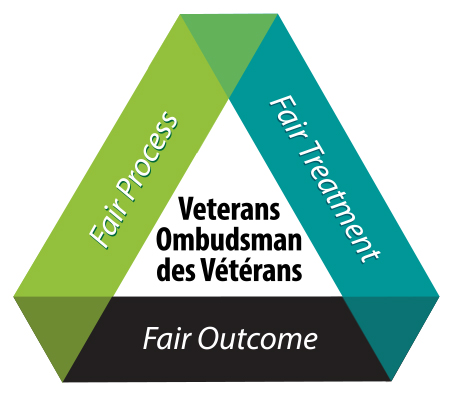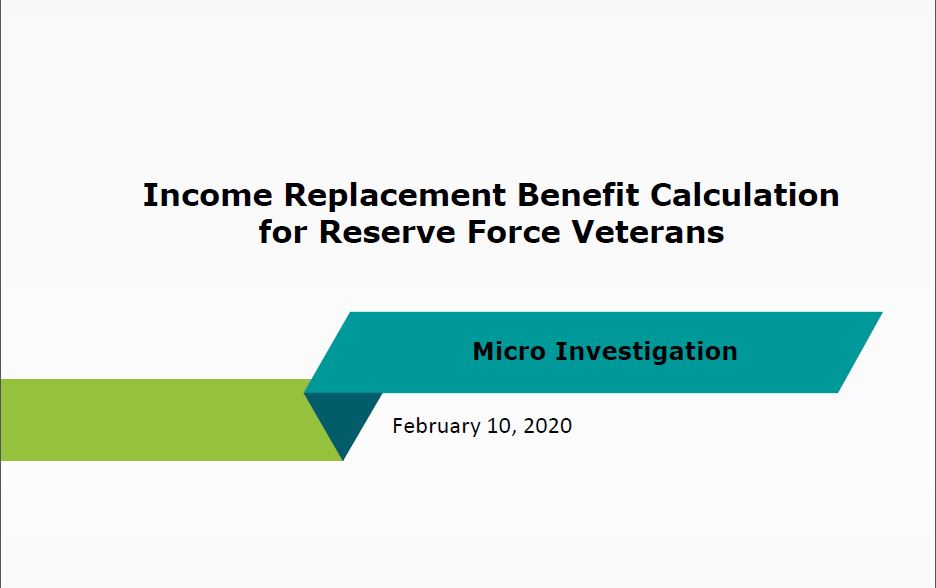Purpose
To investigate complaints from Reserve Force Veterans that the calculation of the Income Replacement Benefit (IRB) – formerly the Earnings Loss Benefit (ELB) - for service-related injury can lead to unfair outcomes compared to Regular Force Veterans in similar circumstances.
Background
Canada's Reserve Force
Class “A” Reservists work part-time. They may work as little as 3 hours per month or as much as 12 full days per month. Class “A” Reservists are paid based on the number of hours they work.
Class “B” Reservists work full-time for a set period of time. Class “B” contracts can be as short as 13 consecutive days or as long as 3 years.
Class “C” service is usually reserved for deployment on domestic or international operations. Reservists on Class C are receiving Regular Force pay and benefits.
The Reserve Force is more diverse than the Regular Force population, with women and visible minorities making up a larger proportion of the formerFootnote 1. Of the CAF Veteran population, women comprise 19% of Reserve Class A and B, 23% of Reserve Class C, and only 13% of the Regular ForceFootnote 2.
In Canada’s new Defence Policy, one of the priorities is to increase Canadian Armed Forces (CAF) agilityFootnote 3. In order to achieve this goal, the CAF will increase reliance on the Reserve Force - augmenting by 1,500 the number of Primary Reservists to a total of 30,000, introducing new operational roles for the Reserve Force and greater integration of the Reserve Force into the CAF.
The IRB is a monthly, taxable benefit that provides income support to Veterans who experience service-related barriers to re-establishmentFootnote 4. The Veterans Affairs Canada (VAC) website explains that eligible Veterans will receive whichever is highest: 90% of salary at release, indexed forward to current day or the minimum threshold, indexed annuallyFootnote 5.
Following an investigation of complaints to our office, the OVO has determined that, in some cases, the IRB for Reserve Force Veterans is calculated using a lower salary than the salary on release, in accordance with paragraph 18(1)(b) of the Veterans Well-Being RegulationsFootnote 6. The salary used to calculate the IRB is the salary at the end of the class of service in which an event occurred that led to the health problem, which may be different from the class of service and salary on release. This salary will be lower than the pre-release salary if the Member has progressed to a higher rank than the rank held when the event occurredFootnote 7.
Approach
The OVO investigates issues using a fairness model with three components: Fair Treatment, Fair Process, and Fair Outcome. Fair Treatment is about how Veterans Affairs relates with Veterans. It includes being honest and forthright when communicating and providing clear, easy-to-understand information. Fair Process is about how decisions are made by Veterans Affairs. It includes informing the Veteran of the decision-making criteria; timely decisions; and meaningful reasons for the decision. Fair Outcome is about whether the ultimate decision is fair. It includes basing decisions on relevant information, equitable decisions, and that similarly situated individuals should expect similar outcomes. The OVO also investigates systemic issues of unfairness where, for example, service-related needs may not be met by current programs, or where the issue is the result of unfair legislation, regulation, or policy.
Discussion / Considerations
Case example
A Reservist is injured in an event in 1996 while on deployment (Class C) at the rank of Master Corporal. The Reservist returns home, continues to serve, and is promoted. Eventually, as a result of the aggravation of the 1996 injury, they are medically released in 2019 from Class A service at the rank of Master Warrant Officer.
This Veteran applies for the rehabilitation program and IRB for the injury sustained in 1996, which has progressively worsened leading to medical release.
The Veteran’s IRB calculation is based on their salary at the time of the injury in 1996 (Class C service at the Master Corporal level), which is significantly less than their pre-release Master Warrant Officer salary.
Unfair Outcome
Had the Veteran been a Regular Force member, the IRB would be calculated based on the 2019 Master Warrant Officer salary, rather than the 1996 Master Corporal salary.
Reservists will find that their class of service changes for a number of reasons, often automatically when the duration of their employment changes, or when they voluntarily deploy to serve their country overseas or in designated domestic operations. Upon return from deployment, their Class will usually change from Class C back to Class A or B. If a Veteran is injured while serving, and they still meet Universality of ServiceFootnote 8Footnote 9 they can continue to serve, even if the injury progressively worsens over time; their continued service enables the continued operational effectiveness of the Canadian Armed Forces (CAF). This continued service is not recognized when the IRB is calculated based on a salary the Reservist received years earlier at a lower rank. In contrast, the full military career of Regular Force Veterans is automatically accounted for when receiving income support for service-related injuries.
Service-related injuries can impact more than the Reservist’s military career. Because many Reservists also hold civilian jobs, service-related injuries may affect that employment, including limiting access to promotions and diminished income earning potential over time. In contrast, when an injury prevents Regular Force members from continuing to serve, the manner in which the IRB is calculated better supports them to maintain their income and hence their standard of living (because their IRB is 90% of their full-time salary on release).
Similarly, the regulation does not account for inevitable changes to an individual’s circumstances as their lives transform over time. Like many Canadians, Reserve Force members’ lifestyle will change consistent with their level of income (mortgages, changing family circumstances, addition of dependents, dependant education costs, etc.). When they release due to service-related injuries, they expect to receive an IRB according to the information provided on VAC’s external website (90% of pre-release salary, indexed). However, unlike their Regular Force counterparts, Reserve Force Veterans may experience financial hardship due to an unexpectedly lower level of income as a result of an IRB calculation that does not meet their needs or expectations as set by VAC. Moreover, if the Veteran is subsequently designated as having Diminished Earning Capacity (DEC), this difference in how the IRB is calculated for Reservists could continue to impact their financial well-being throughout their lives.
The increased support that the Reserve Force will provide the CAF only highlights the importance of updating the regulations to ensure fairness for this group of Veterans. Would potential recruits consider joining the Reserve Force if they knew they might be compensated less than their Regular Force counterparts in a similar situation?
Following our inquiries, VAC provided the OVO with two policy rationales to explain the inequitable IRB calculation method:
-
The regulation was drafted to be consistent with the 2006 Regulatory Impact Assessment Statement where it was noted that the calculation of the ELB will mirror as closely as possible the long-term disability benefit provided now under SISIP (CAF-LTD)Footnote 10.
Part 3 of the Service Income Security Insurance Plan (SISIP) - Policy 901102, the CAF Long-term Disability program uses a similar approach. The regulations appear to have been derived from the SISIP policy without due consideration for the impact on all scenarios where a member releases from the Reserve Force. Mirroring of SISIP / CAF LTD policy is not an adequate rationale. VAC diverged from the SISIP model in 2015 when VAC changed the imputed salary for Class A and B Reservists (with less than 180 days service) from $2700 (SISIP rate) to the greater of the monthly military salary or the salary of a basic corporal. In 2016 they diverged again by increasing ELB for all Veterans from 75% of imputed salary to 90%. Maintaining the SISIP rationale does not justify a lower IRB calculation for Reservists who release at a higher rank than the rank when the event occurred leading to the service-related injury.
-
If the Veteran took a demotion to leave the Regular Force and join the Reserve Force it would be a disadvantage to base the calculation on the rank at release from the Reserve ForceFootnote 11.
VAC advised that this scenario is not uncommon, but did not provide any supporting data. This rationale does not justify the inequity that applies in other cases. As currently written, the regulation is only beneficial when the member releases at, or soon after, the time of injury and when the Regular Force rank was higher or equivalent to the Reserve Force rank upon release. In the current IRB policy and the past two ELB policies, there have been clauses that allow the Department to consider progressive illnesses only if the physical or mental health problem cannot be associated with a specific event / period of service. In contrast, Veterans who release from Regular Force service automatically receive consideration for progressive worsening of health problems over time, due to service, and automatically have their IRB calculated based on their salary at release.
To avoid unintentional systemic biasFootnote 12 against Reserve Force members and Veterans, it is important that policy developers apply a Reservist lens when developing or updating policies. This would include taking into consideration the context of different types of Reserve Force service, and the variety of career trajectories within the Canadian Forces between different classes of service.
The OVO asked VAC to provide us with the number of Reserve Force Veterans who have their IRB calculated under this paragraph of the regulations. We were advised that these decisions are not tracked, and thus the numbers are unavailable. VAC could only provide the number of former Reserve Force Members who were eligible for the benefit: almost 3,000 Veterans in 2018.
Conclusion
We have determined based on our investigation of complaints, that the IRB calculation can result in unfair outcomes for Reserve Force Veterans. The result is often inequitable for survivors and orphans of deceased Reserve Force Members and Veterans as well, for their IRB is calculated in the same manner as described above.
Recommendation 1:
Amend the Veterans Well-being Regulations to ensure that Income Replacement Benefits are fairly calculated for Veterans releasing from any class of Reserve Force service.
The OVO suggests the following change to the wording of paragraph 18(1)(b) of the Veterans Well-being regulations (and other relevant sections):
For a Veteran whose final release is from the Reserve Force, select the greater of:
- the Veteran’s monthly military salary at the time of release;
- the Veteran’s monthly military salary at the time of release from the class of service wherein the event that resulted in the health problem leading to the release occurred; or
- the set minimum salary.
Recommendation 2:

Rectify unintentional systemic bias by applying a Reservist lens in policy development.
The calculation of the IRB for Reserve Force Veterans leads to unfair outcomes. Using a lower salary than the pre-release salary to calculate the IRB has the following consequences:
- Does not compensate for military career progression
- Does not meet expectations set by VAC (90% pre-release salary)
- Can lead to financial hardship for Veterans and their families
